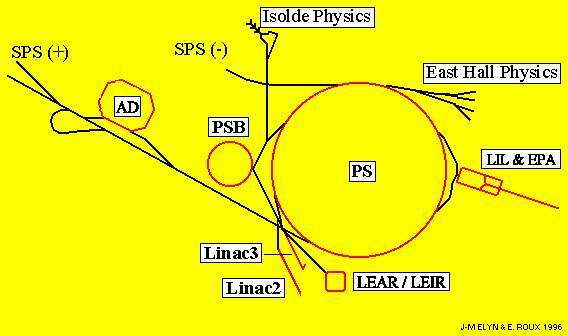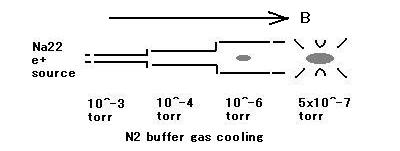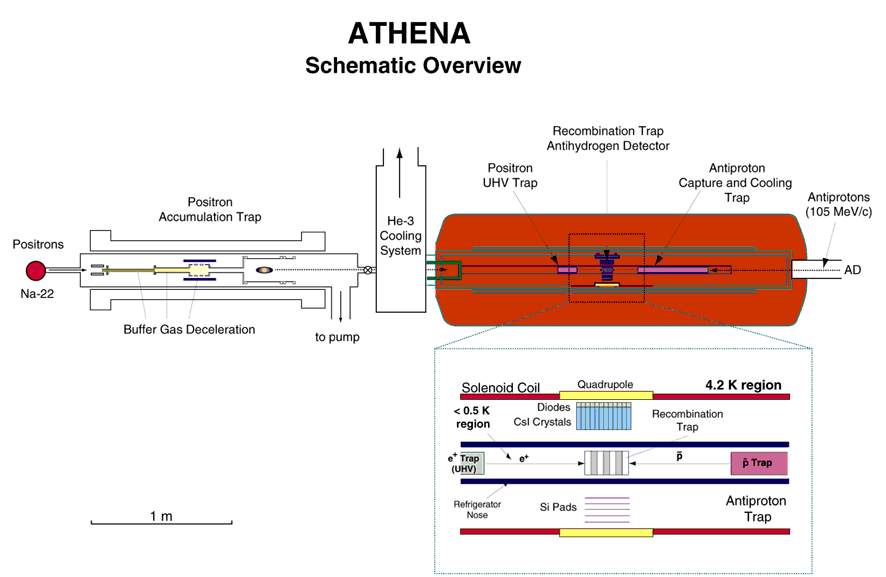Low Energy Antiproton + Positron
Low Energy Antiprotons (< 1 eV)
Antiprontons were first discovered in 1957 with an accelerator "bevatron" at UC Berkeley by E.G.Segre and O.Chamberlain.
In the PS Complex at CERN shown in the figure below, antiprotons are now routinely produced for various experiments.
The 26 GeV/c production beam coming from the PS shoots the production target placed at the entrance of AD. About 5x10^7 antiprotons are injected into AD at 3.57 GeV/c. After the injection into AD, bunch rotation, stochastic cooling and electron cooling are applied for cooling antiprotons with an estimated efficiency of 25%. About 1.2x10^7 are available at low energy (100 MeV/c or 5.6 MeV) for the experiments. The cycle time is roughly 2 minutes.

Further deceleration is performed with a degrader foil to catch ~10 keV antiprotons inside a Penning trap. These antiprotons can be cooled to less than 10 K with electron cooling inside the trap.
Low Energy Positrons (< 1 eV)
Positron was first found in 1931 by C.D.Anderson with a cloud chamber. Since then high energy positron beams have been used in many fields of research. Low energy positrons are also used but only with small numbers (<10^4). However, N2 gas buffer cooling of positrons thermalised with solid Neon moderator has recently achievted the confinement of ~10^8 positrons at room temperature. The confinement time of positrons is ~1700 sec at pressure of 7x10^-10 torr and ~45 sec at 6x10^-7 torr. It is expected that this large number of positrons is feasible for the production of Antihydrogen.

Experiments with Low Energy Pbar and e+ (ATHENA)
There are a few experiments which try to produce "Antihydrogen" at low energy. Although it seems straightforward to make "Antihydrogens", high density (> 10^8 /cm3) antiprotons and positrons are necessary at very low temperature (< 4 K) to get an enough cross section for the production of "Antihydrogen". The problem is that the popular laser cooling technique is not available since antiprotons and positrons are elementary particles. It is still unknown what is the best way to make "Antihydrogen".

Atomic Spectroscopy And Collisions Using Slow Antiprotons (ASACUSA)
Low energy antiproton beams (< 20 eV) are expected to open a new research field. ASACUSA employed Radio Frequency Quadrupole Decelerator (RFQD) to get pulsed antiproton beams of 15 ~ 120 keV effectively. ASACUSA trap is in charg of producing low energy antiproton beams of 10 ~ 1000 eV. To obtain intense low energy antiproton beams effectively, electron cooling of high energy protons in ASACUSA trap was investigated in advance (details).
References
G.Gabrielse, et. at., Phys.Rev.Lett. 63 (1989) 1360
R.G.Greaves, M.D.Tinkle and C.M.Surko, Phys.Plasmas 1 (1994) 1439
Back to the top